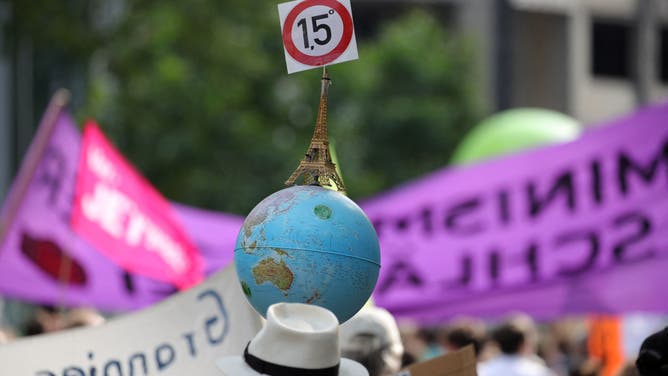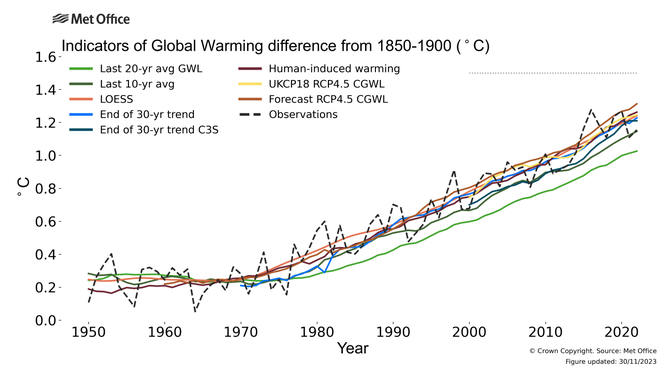Measuring global warming: No one can agree how to calculate 1.5-degree increase in Paris Agreement
Confusion on how to measure the 1.5-degree Celsius increase will serve as a distraction and delay action, U.K. Met Office scientists warn. Current U.N. projections suggest the 1.5-degree breach will occur around 2030 but would not be formally recognized until 2040 if a 20-year average is used.
Largest closed ecological system focuses on solving climate change problems
Biosphere 2, the world’s largest controlled environment, looks to solve problems presented by climate change. Director Joaquin Ruiz tells FOX Weather’s Max Gorden just how groundbreaking his station is.
World leaders and renowned scientists are taking center stage at COP28, the U.N.’s Climate Change Conference, fervently arguing about how to keep the world within a 1.5-degree Celsius global temperature rise. But no one can agree on how to measure 1.5 degrees.
The 1.5-degree Celsius threshold was established by the 2015 Paris Accord. That is an international pact of nearly 200 nations agreeing to do their own part in reducing greenhouse gases to keep global warming in check.
"It might come as a surprise, then, to hear that the Paris statement contains no formally agreed way of defining the present level of global warming," wrote a team of scientists from the United Kingdom's Met Office, the U.K.’s equivalent to the U.S. National Weather Service. "The pact does not even define ‘temperature increase’ explicitly and unambiguously."
2023 ‘VIRTUALLY CERTAIN’ TO BE WORLD'S HOTTEST YEAR ON RECORD, SCIENTISTS SAY

File: A demonstrator carries a globe with a model of the Paris Eiffel Tower, with reference to the 2015 Paris Agreement to limit global warming preferably to 1.5 degrees Celsius, during a demonstration in Frankfurt, Germany.
(ARMANDO BABANI/AFP / Getty Images)
No ‘instantaneous’ measure to figure out which year starts the over 1.5 trend
The issue is that global temperatures don’t increase smoothly, the scientists said in a report published in the journal Nature. The report serves a suggestion about how the 1.5 degrees should be measured.
"The brief ups and downs that occur over weeks to years owing to natural climate variability (caused, for instance, by El Niño events and the effects of gases given off by volcanic activity) are superimposed on the long-term warming trend from human influences," the report said. "For example, the global mean temperature rise exceeded 1.5 °C briefly for a month or more in 2016, 2017, 2019, 2020 and 2023."
Brief "warm spells" or even one warm year would not breach the Paris Agreement, they explained. Even the World Meteorological Organization’s analysis that the global average temperature will exceed 1.5 degrees (2.7 degrees Farenheit) for at least one year within the next five years will likely be temporary.
WHERE DOES YOU STATE RANK ON THE ‘2023 GREENEST STATES’ LIST?

Various indicators of global surface warming. An annual timeseries of global surface temperature anomaly relative to the 1850-1900 average, based IPCC methods (Forster et al., 2023), is shown by the dashed line. All other lines represent indicators of long-term surface temperature rise. A full description of each indicator is provided in Table 1, below. A dotted line at 1.5°C is shown on the right hand end of the plot to guide the eye.
(Met Office / FOX Weather)
"Without an agreed metric, there can be no consensus on when the 1.5 °C level has been reached," the report stated. "This is likely to result in distraction and delay just at the point when climate action is most urgent."
How to measure the average global temperature to account for human-induced changes instead of climate variability
But how to "filter out" natural climate cycles remains debated. The U.N.’s recent climate assessment report defines the 1.5-degree global warming level (GWL) as a 20-year average compared to the pre-industrial level between 1850 and 1900. But that would make warming a hindsight, authors of the report argue.
"The year of exceedance of a GWL is the midpoint of the 20-year period at that level," the scientists explained. "By this definition, 1.5 °C of warming would be confirmed once the observed temperature rise has reached that level, on average, over a 20-year period – in other words, a decade after crossing the 1.5 °C level. That risks a delay in recognizing and reacting to the crossing point."
CLIMATE CHANGE MAY BE KEEPING YOU FROM GETTING A GOOD NIGHT'S SLEEP, STUDY SAYS

File: An event banner outside the Al Wasl dome in the Green Zone ahead of the COP28 climate conference at Expo City in Dubai, United Arab Emirates, on Tuesday, Nov. 28, 2023. More than 70,000 politicians, diplomats, campaigners, financiers and business leaders will fly to Dubai to talk about arresting the world's slide toward environmental catastrophe.
(Hollie Adams/Bloomberg via Getty Images / Getty Images)
Current U.N. forecasts show the GWL to exceed 1.5 degrees by 2030 (plus or minus 10 years). However, since the accepted warming between 2003 and 2022 was 1.03 degrees (which can be anywhere from a 0.87-1.13 degree rise, accounting for uncertainties), the first time the 20-year average would be over 1.5 degrees would be in 2040. This is still not detailed in the Paris Agreement.
Authors of the report suggest averaging the previous 10 years of temperatures with a 10-year projection to establish an "instantaneous" indicator for policy issues that can later be verified with the 20-year average statistic. The next U.N. assessment report is not expected until 2030. No amendment to the Paris Accord has been discussed.
